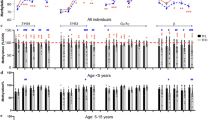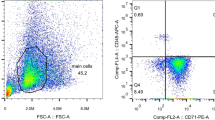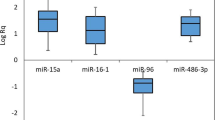Abstract
The mechanism that drives the switch from fetal to adult hemoglobin (Hb) provides a therapeutic target for β-thalassemia. We have previously identified that hypermethylation of transcription factor ERF promoter reactivated γ-globin expression. To uncover the mechanism underlying the hypermethylation of ERF promoter, we performed RNA sequencing in β0/β0-thalassemia patients and identified an upregulated long noncoding RNA (RP11-196G18.23) associated with HbF production. RP11-196G18.23 bound to the ERF promoter and recruited DNA methyltransferase 3A to promote DNA hypermethylation-mediated ERF downregulation, thereby ameliorating ERF-induced γ-globin inactivation. The identification of RP11-196G18.23 provides an epigenetic mechanism for the reactivation of fetal γ-globin expression for β-hemoglobinopathies.
Similar content being viewed by others
Introduction
Reactivating fetal hemoglobin (HbF, α2γ2) holds a therapeutic target for β-thalassemia and sickle cell disease. Several modulators, such as transcription factors (TFs) BCL11A and LRF, have been uncovered to regulate HbF expression by directly binding to γ-globin promoter [1, 2]. Our previous study also identified the transcription factor ERF as a repressor of HbF that binds to two regulated elements—one located 3.5 kb upstream of HBG2 and the other 1.5 kb downstream of HBG1 [3]. We found that the hypermethylation-mediated transcriptional inactivation of ERF can reproduce γ-globin in high HbF β-thalassemia patients. However, the molecular mechanism underlying the hypermethylation of the ERF prompter in high HbF patients remains unclear. Recently, long noncoding RNAs (lncRNAs) have emerged as critical regulators of gene expression, performing functions in cis or in trans. Such regulators have already been shown to play regulatory roles in normal erythropoiesis and disease conditions, including erythroid cell survival, heme metabolism, globin switching and regulation, etc [4,5,6]. For example, a lncRNA transcribed from the pseudogene HBBP1 locus interacts with the TF ELK1 to regulate the expression of γ-globin gene [7]. In addition, HMI-LNCRNA transcribed by MYB enhancer region can inhibit HbF expression and delay erythroid maturation [8], but the specific mechanism is not clear. These studies indicate that lncRNAs are involved in the regulation of γ-globin expression, but the mechanism by which lncRNAs regulate γ-globin expression through TFs interaction needs to be further studied. Here, we performed strand-specific RNA-seq analysis of bone marrow (BM)-derived GYPA+ erythroid cells from 6 β0/β0-thalassemia patients who were stratified into low- (HbFL: 0.1–0.4 g/dL, n = 3) and high HbF (HbFH: 8.9–9.2 g/dL, n = 3) expression groups used in our previous study [3] to screen for differentially expressed lncRNAs (DE-lncRNAs) associated with HbF production and their participation in regulating ERF expression.
Materials and methods
Patients and RNA sequencing (RNA-seq)
RNA-seq analysis was performed based on the patients in our previous study [3]. These patients were divided into two group (HbFH: 8.9–9.2 g/dL, and HbFL: 0.1–0.4 g/dL) based on the HbF level. All patients gave the informed consent (Additional file 1). Differentially expressed lncRNAs (DE-lncRNAs) between HbFH and HbFL groups of β0/β0-thalassemia patients were screened according to the following criteria: |log2FoldChange|> 0.5 and probability ≥ 0.8. More details were provided in the Additional file 1.
In vitro validation
Coding potential ability of lncRNA RP11-196G18.23 was performed using open reading frame finder from NCBI and phyloSCF in silico prediction. Subcellular localization of RP11-196G18.23 in the HUDEP-2 cell line was identified using Fluorescence in situ hybridization (FISH). Chromatin isolation by RNA purification (ChIRP), RNA immunoblotting and RNA immunoprecipitation were employed to detect the interaction among RP11-196G18.23, ERF promoter and DNA methyltransferases DNMT1and DNMT3A. Chromatin immunoprecipitation (ChIP) was performed to investigate the enrichment of DNMT3A to ERF promoter. CRISPR/Cas9 system was used to delete the binding sequences of RP11-196G18.23 on ERF promoter. Bisulfite sequencing was performed to detect methylation level of CpG sites in ERF promoter. More details were descried in the Additional file 1. A two-tailed Student’s t test and ANOVA from SPSS v.20 software were used for comparisons between the indicated groups studied. p values of less than 0.05 were considered to be statistically significant.
Results and discussion
We analyzed the DE-lncRNAs between HbFH and HbFL groups and identified 62 lncRNAs that showed significant, HbF production-associated alterations. Among them, an HbF-associated upregulated lncRNA RP11-196G18.23 (LogFC = 0.5 and probability = 0.8; Fig. 1A, Additional file 1: Table S1) was predicted to have binding sites in the ERF promoter region using the LongTarget tool (Fig. 1B). We then validated the expression of RP11-196G18.23 in the β0/β0-thalassemia patients using real-time quantitative reversely transcribed PCR (qRT-PCR) and confirmed that RP11-196G18.23 expression in the high HbF group was approximately three times higher than that of the low HbF group (Additional file 1: Fig. S1A). To determine the relationship between RP11-196G18.23 and ERF, we first characterized the protein coding ability and subcellular localization of RP11-196G18.23. RP11-196G18.23 had no protein coding ability, as predicted by in silico analysis (Additional file 1: Fig. S1B) and an in vitro experiment involving the fusion of open reading frame (ORF) and EGFP (Additional file 1: Fig. S1C–E), and it was predominantly expressed in the nucleus, as determined by fluorescence in situ hybridization (FISH) (Additional file 1: Fig. S1F). We then analyzed the public RNA-sequencing data (GSE53983) of CD34+ HSPCs from Gene Expression Omnibus database (GEO) and observed a negative correlation between ERF and RP11-196G18.23 (Fig. 1C). LncRNAs are reported to repress genes by binding to the promoter and recruit DNMTs to mediate the DNA methylation of target regions [9]. In addition, our previously study [3] demonstrated that DNMT3A participates the regulation of ERF. Thus, we hypothesized that RP11-196G18.23 might mediate ERF hypermethylation and downregulation by binding to its promoter, which could be involved in reactivation of HBG expression. To validate whether RP11-196G18.23 could inhibit ERF expression by binding to its promoter, we performed ChIRP analysis using RP11-196G18.23 overexpressed HUDEP-2 cell lysates (Fig. 1D). We observed that RP11-196G18.23 could bind to ERF, as demonstrated by qPCR analysis of DNA (Fig. 1E) or RNA (Fig. 1F) retrieved from RP11-196G18.23-ChIRP. We then carried out immunoblotting analysis using anti-DNMT3A and DNMT1 antibodies in HUDEP-2 cells. We observed that RP11-196G18.23 could bind to DNMT3A but not DNMT1 (Fig. 1G, H). Protein retrieved from RP11-196G18.23-ChIRP also confirmed this result (Fig. 1I). ChIP-qPCR analysis of the HUDEP-2 cell lysate confirmed that RP11-196G18.23 enhanced the recruitment of DNMT3A to the ERF promoter region (Fig. 1J). These data indicate that lncRNA RP11-196G18.23 could bind to ERF promoter and interact with DNMT3A.
LncRNA RP11-196G18.23 binds to ERF promoter and interacts with DNMT3A. A Flowchart of DE-lncRNAs analysis and candidate lncRNAs screening. DE-lncRNAs were analyzed according to log2Ratio > 0.5 and probability > 0.8. LongTarget was used to predict the interactive lncRNAs on ERF promoter. B RP11-196G18.23 was predicted to bind to the ERF promoter shown in the UCSC genome browser. The orange peaks show the binding region of RP11-196G18.23 in the ERF promoter. The number above ‘0’ indicates the maximal number of overlapping triplexes at an address in the region. The shadowed light green bar marks the lncRNA binding sites in the promoter regions. C Regression analysis between ERF and RP11-196G18.23 expression based on the data from GEO database (GSE53983). The gray region indicated the 95% confidence interval. D Copy number of RP11-196G18.23 overexpression in HUDEP-2 and CD34+ HSPCs. E, F ChIRP analysis of RP11-196G18.23 interaction with ERF in RP11-196G18.23 OE HUDEP-2 cells. The retrieved ERF DNA (E) and RNA (F) was quantified by qPCR. LacZ, negative control probe. Odd and even, the RP11-196G18.23 probes. ERF p1 and p2, two fragments on ERF promoter. GAPDH, negative control for qPCR. G RIP analysis of interaction of RP11-196G18.23 with DNMT3A in HUDEP-2 cells. IgG, the control for the specificity of the anti-DNMT3A antibody. GAPDH, the negative control. H RNA pull-down analysis of specific association of DNMT1 or DNMT3A with lncRNA RP11-196G18.23 in RP11-196G18.23 OE HUDEP-2 cells. Non-template control (NTC), negative control. AS, antisense sequence of RP11-196G18.23. I Western blot analysis of the protein retrieved from RP11-196G18.23-ChIRP. J ChIP analysis of association of DNMT3A with the ERF promoter (p1 and p2 region) was performed using HUDEP-2 cells without (Ctrl) or with RP11-196G18.23 OE. MYOD1, negative control for qPCR. Data are shown as the means ± SEM from at least two independent experiments (*p < 0.05; ***p < 0.001)
In the nucleus, lncRNAs regulate gene expression by controlling the local chromatin structure or recruiting regulatory molecules to specific loci. A lncRNA BGLT3 has been reported to regulate γ-globin transcription both in cis and in trans [6]. In cis, BGLT3 gene locus transcriptionally activates fetal γ-globin genes via facilitating chromatin looping between LCR and γ-globin promoters [4]. In trans, BGLT3 interacts with the Mediator complex, such as MED12 on chromatin to aid γ-globin transcriptional assembly [10]. Therefore, we wonder if RP11-196G18.23 could mediate the ERF promoter hypermethylation by recruiting DNMT3A and leads to reactivation of γ-globin. To validate this hypothesis, we overexpressed RP11-196G18.23 in HUDEP-2 cells and CD34+ HSPCs (Fig. 1D). We observed that the methylation level of ERF promoter was significantly increased, while the endogenous ERF mRNA and protein levels were decreased both in HUDEP-2 cells (Fig. 2A–C) and CD34+ HSPCs (Fig. 2D, E). DNMT3A also enriched in the ERF promoter after RP11-196G18.23 overexpression (Fig. 1I). More importantly, we observed that RP11-196G18.23 overexpression could stimulate γ-globin mRNA and protein levels in both HUDEP-2 cells (2.1-fold change relative to the control) (Fig. 2B, C) and CD34+ HSPCs (7.7% of total hemoglobin in RP11-196G18.23 overexpression CD34+ HSPCs, compared with 2.0% in control cells) (Fig. 2F). However, compared with the effect of major regulators such as BCL11A and LRF on the level of HbF, the effect of RP11-196G18.23 overexpression on γ-globin reactivation is modest. This is probably due to the indirect effect of RP11-196G18.23 in regulating γ-globin rather than direct binding to the HBG promoter. In addition, there may be some other complexes binding to ERF promoter remain to be uncovered. To further determine the association between RP11-196G18.23 and ERF promoter, we disrupted the binding sequences of RP11-196G18.23 on ERF promoter and found that the expression of ERF was significantly increased while the γ-globin was decreased (Fig. 2G and Additional file 1: Figure S2). Our previously study [3] also demonstrated that the expression of ERF was decreased after hypermethylation on ERF promoter by site-specific methylation through dCas9-MQ1-sgRNA system, and consequently, the γ-globin expression was increased. Altogether, these results demonstrated that RP11-196G18.23 could inhibit ERF gene expression to reactivate HBG expression by recruiting DNMT3A and enhancing ERF methylation (Additional file 1: Figure S3).
LncRNA RP11-196G18.23 mediates ERF promoter hypermethylation and leads to reactivation of γ-globin. A The ERF promoter methylation level examined by clone-seq in HUDEP-2. Each row of eight CpG sites within a group represents a single bisulfite-treated clone with methylated CpGs (●) or unmethylated CpGs (○). B, C The ERF and γ-globin mRNA and protein levels were examined by qPCR (B) or Western blotting (C) in RP11-196G18.23 OE HUDEP-2 cells. The band intensities measured by ImageJ were showed underneath each panel. D The ERF promoter methylation level in CD34+ HSPCs. E, F The ERF protein level examined by Western blot (E) and the Hb F production examined by HPLC (F) in CD34+ HSPCs. G qPCR analysis of ERF and γ-globin mRNA level in wild type (Ctrl) and RP11-196G18.23 binding sequences disrupted HUDEP-2 cells. Data are shown as the means ± SEM from at least two independent experiments (*p < 0.05; ***p < 0.001)
In conclusion, our study demonstrated that RP11-196G18.23 bound to ERF promoter and then recruited DNMT3A to mediate hypermethylation of ERF promoter, resulting in downregulation of ERF and upregulation of γ-globin in patients with high HbF. Our research provides an epigenetic mechanism for the reactivation of fetal γ-globin expression.
Data availability
All the data were showed through the whole manuscript and Additional file 1. Public data (GSE53983) were available in Gene Expression Omnibus database (GEO).
References
Martyn GE, et al. Natural regulatory mutations elevate the fetal globin gene via disruption of BCL11A or ZBTB7A binding. Nat Genet. 2018;50:498–503.
Masuda T, et al. Transcription factors LRF and BCL11A independently repress expression of fetal hemoglobin. Science. 2016;351:285–9.
Bao X, et al. Epigenetic inactivation of ERF reactivates gamma-globin expression in beta-thalassemia. Am J Hum Genet. 2021;108:709–21.
Feng R, et al. Activation of gamma-globin expression by hypoxia-inducible factor 1alpha. Nature. 2022;610:783–90.
Ren Y, et al. Regulatory association of long noncoding RNAs and chromatin accessibility facilitates erythroid differentiation. Blood Adv. 2021;5:5396–409.
Xu C, Shi L. Long non-coding RNAs during normal erythropoiesis. Blood Sci. 2019;1:137–40.
Ma SP, et al. Long noncoding RNA HBBP1 enhances gamma-globin expression through the ETS transcription factor ELK1. Biochem Biophys Res Commun. 2021;552:157–63.
Morrison TA, et al. A long noncoding RNA from the HBS1L-MYB intergenic region on chr6q23 regulates human fetal hemoglobin expression. Blood Cells Mol Dis. 2018;69:1–9.
Xu SF, Zheng Y, Zhang L, Wang P, Niu CM, Wu T, Tian Q, Yin XB, Shi SS, Zheng L, Gao LM. Long non-coding RNA LINC00628 interacts epigenetically with the LAMA3 promoter and contributes to lung adenocarcinoma. Mol Ther Nucleic Acids. 2019;18:166–82.
Ivaldi MS, et al. Fetal gamma-globin genes are regulated by the BGLT3 long noncoding RNA locus. Blood. 2018;132:1963–73.
Acknowledgements
We thank Dr. Ryo Kurita and Dr. Yukio Nakamura for providing the HUDEP-2 cells, Qifa Liu and Feijin Chen for providing the CD34+ HSPCs. We appreciate useful suggestions from Erwei Song and Xichen Bao.
Funding
This study was supported by the National Key R&D Program of China (2018YFA0507800 and 2018YFA0507803), National Natural Science Foundation of China (grant no. 82100136), the Guangzhou Municipal Science and Technology Project (grant no. 202201011361) and Guangdong Basic and Applied Basic Research Foundation (grant no. 2022A1515220207).
Author information
Authors and Affiliations
Contributions
XB, CZ and XX designed the study and wrote the paper. XB, ZW, YG, YY and JH performed the experiments and analyzed the data. DC and YZ collected the samples. All authors read and approved the final manuscript.
Corresponding authors
Ethics declarations
Ethics approval and consent to participate
Approval for the study was obtained as outlined by the protocol #202201202 approved by Medical Ethics Committee of Guangdong Women and Children Hospital. The study was conducted in accordance with the Declaration of Helsinki.
Consent to participate
Informed consent was obtained from all the participants prior to the study following presentation of the nature of the procedures.
Competing interests
The authors declare no competing interests.
Additional information
Publisher's Note
Springer Nature remains neutral with regard to jurisdictional claims in published maps and institutional affiliations.
Supplementary Information
Additional file 1
. Materials and methods, tables and figures.
Rights and permissions
Open Access This article is licensed under a Creative Commons Attribution 4.0 International License, which permits use, sharing, adaptation, distribution and reproduction in any medium or format, as long as you give appropriate credit to the original author(s) and the source, provide a link to the Creative Commons licence, and indicate if changes were made. The images or other third party material in this article are included in the article's Creative Commons licence, unless indicated otherwise in a credit line to the material. If material is not included in the article's Creative Commons licence and your intended use is not permitted by statutory regulation or exceeds the permitted use, you will need to obtain permission directly from the copyright holder. To view a copy of this licence, visit http://creativecommons.org/licenses/by/4.0/. The Creative Commons Public Domain Dedication waiver (http://creativecommons.org/publicdomain/zero/1.0/) applies to the data made available in this article, unless otherwise stated in a credit line to the data.
About this article
Cite this article
Bao, X., Gao, Y., Wang, Z. et al. Activation of γ-globin expression by LncRNA-mediated ERF promoter hypermethylation in β-thalassemia. Clin Epigenet 16, 12 (2024). https://doi.org/10.1186/s13148-023-01614-6
Received:
Accepted:
Published:
DOI: https://doi.org/10.1186/s13148-023-01614-6






